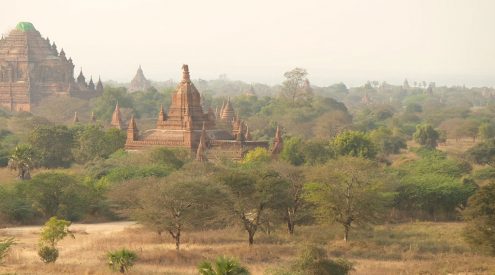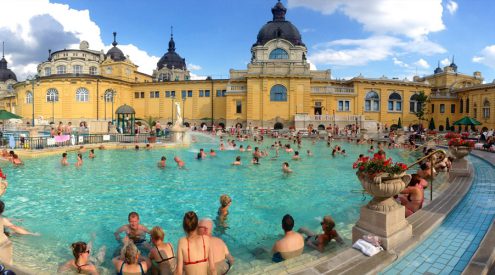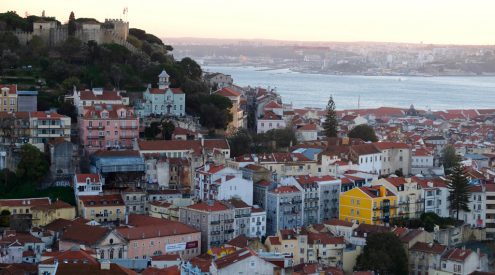Warsaw is a fascinating destination, a crucible of Europe in the 20th century. Graham Howe followed the Royal Route in Warsaw through the 1000-year-old city alive with the sounds of native son Chopin – travelling back in time through the Warsaw uprising, the Jewish ghetto and the Soviet occupation.
The Royal Route in Warsaw
Every Sunday from May to September, Chopin still gives a free open-air concert in the Royal Lazienkowski Park in Warsaw. Or one of his many protégés does.
Chopin’s music – especially the mazurka and polonaise – are based on traditional Polish folk tunes you still hear played out in the country. Mingling with the crowds gathered on the lawns, we listened to a maestro play Chopin in the sunshine in a huge park of water palaces, pavilions and lakes. Sitting beneath a foppish statue of one of Poland’s most musical sons, the piano man plays a lively polonaise. Tourists and local families come to picnic in the park every weekend, falling under Chopin’s spell in the laidback spirit of summer in Warsaw.
The streets of Warsaw are alive with the sound of music. On the historic royal route through the heart of the city delighted children sit on a row of Chopin benches which mysteriously play his compositions on a digital loop they download onto cell phones. At the Church of the Holy Cross, they take ghoulish pleasure when a teacher points out the shrine where Chopin’s heart is entombed in his old hometown. After his death from TB aged 38, his sister brought his heart back from Paris to Warsaw. School is out across Europe – and orderly lines of children are on outings to see the new tourist attractions of Warsaw.
Opened to commemorate the two hundredth anniversary of the great composer’s death, the Chopin Museum, set in a seventeenth century Baroque townhouse in Warsaw, houses the biggest collection of Chopin memorabilia in the world. It is very high-tech – with sound-booths that play one of his works at the touch of a screen and a piano that plays when you turn the music sheets. We also visited Chopin’s birthplace, a country villa west of Warsaw – which also hosts free concerts in summer – and has exquisite landscaped gardens and a museum.
If you’re trying to think of other famous Poles, Nicholas Copernicus is another. At his monument, a teacher patiently explains the replica solar system in the hands of the famous astronomer who proved that the earth moves around the sun. Science and play go hand in hand at Warsaw’s futuristic Copernicus Science Centre, opened in 2010 to mark his 500th anniversary. At 101 high-tech exhibits, the whole family get to experience a virtual earthquake, tornado and gravity, see the world through the eyes of a snake, dog and fish, learn about the human body – and blast recyclable objects into virtual space. Science was never this much fun when I was at school.
The royal route through Warsaw takes tourists travelling back in time from the magnificent thirteenth century palace in the old town, across the moat and castle walls to “new” town (only 500 years old!) past magnificent cathedrals, churches and medieval squares. Warsaw is a tourist-friendly city best explored on foot – wandering the cobbled streets with al fresco restaurants, bars and jazz clubs. At night, fire eaters, organ-grinders and buskers entertain the crowds in the huge castle square. Warsaw is a very green city located on either side of the Vistula River – and in summer, adults, children and their dogs cool off in the fountains and waterways along the river bank.
Looking at the chic cafes, high-rise western hotels and boutique fashion shops of Warsaw today, it is difficult to imagine Poland was under communist rule for almost fifty years until 1989. Even the social realist style of many monuments erected during the Soviet occupation has become a tourist attraction today. Warsaw has led so many lives – with layers of living history reflected in the styles of buildings from the dark ages to the cold war. We even visited the Warsaw Stock Exchange, a symbol of the new capitalism in Poland, originally housed in the old Communist Party headquarters!
I enjoyed visiting the Palace of Culture & Science build by the Soviets in the 1950s. This concrete monolith – called Stalin’s wedding cake and the palace of malice by locals – towers above the heart of the old Warsaw ghetto destroyed in World War II. Still the highest building in the city at 230 metres, it has the fastest lift in Europe which takes you to an observation deck 30 floors up in 20 seconds. (“Don’t worry” says the guide, “We replaced the old Soviet one!”) The views of Warsaw are spectacular. When Yuri Gagarin, the Soviet astronaut, visited, he said “My, it is high!”
Warsaw was completely destroyed during the Second World War. Of a population of 1,3m before the war, only 1000 inhabitants survived in Warsaw at the end of the war. The old and new town were rebuilt in a mere decade as Poland rose like a phoenix from the ashes in the 1950s.
An award-winning 3-D Imax film at the Warsaw Uprising Museum, another major new tourist attraction, tells the story. Opened to mark the 60th anniversary of the ghetto and city uprising, the museum tells the story of the city’s heroic resistance from 1943-45 to the German invasion. History buffs experience the recreation of street battle scenes in war-torn Warsaw – down to the children who acted as scouts and runners conveying messengers thru the sewers.
Before WWII, Warsaw was the second biggest Jewish community in Europe with over 450 000 Jewish residents – few survived the holocaust. Visitors can follow a route through Jewish Warsaw. We visited remnants of the old brick wall built by the Nazis in 1940 to imprison the Jews of Warsaw in the ghetto – most were exterminated in the Treblinka and Auschwitz death camps built by the Nazis in Poland, also a Unesco world heritage site today. There are several moving monuments to the heroes of the ghetto uprising of 1943 – as well displays in the Warsaw uprising museum. It is estimated that six million Jews and Poles died during the second world war.
You can find everything from sushi and Thai to Indian and global cuisine in the smart restaurants of Warsaw – but I was after traditional Polish cuisine. We sampled a few of Warsaw’s delightful old restaurants in old town – set in centuries-old cellars and townhouses. Poland is famous for its hearty fare, big soups (borscht and zurek) cabbage (bigos – a cabbage and venison dish), Baltic fish, pork, duck, sausages, venison, dumplings and potato cakes – and we were there during the cherry and mushroom season. Poland is also famous for vodka and beer – but more of that good country cuisine as we head east of Warsaw into the heart of the Polish countryside.
To be continued






























